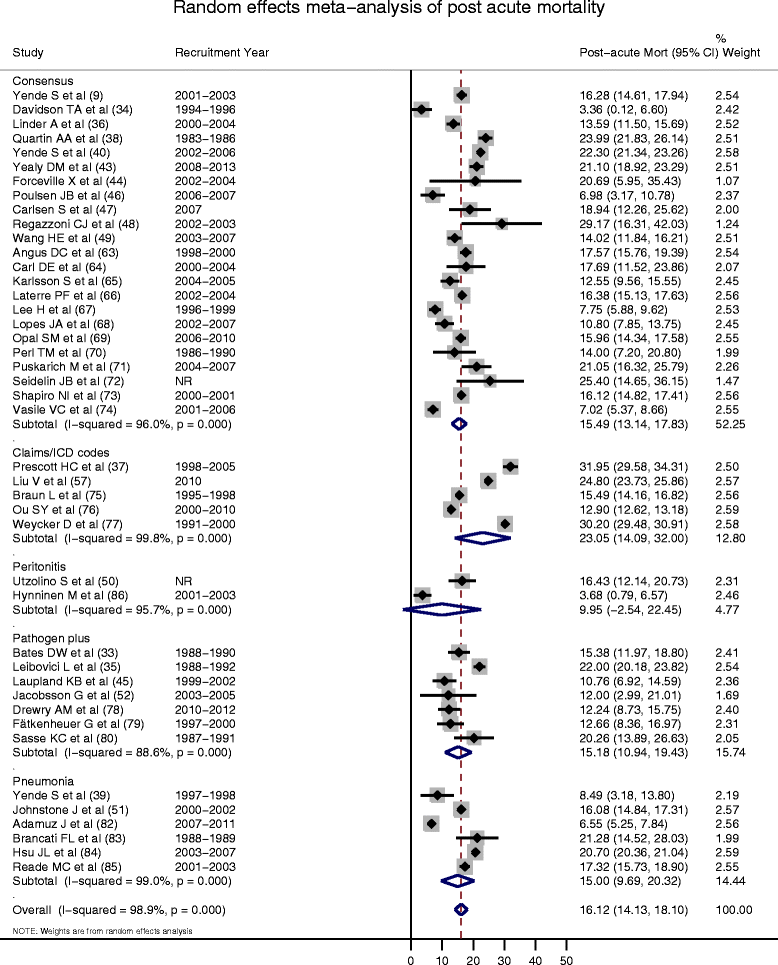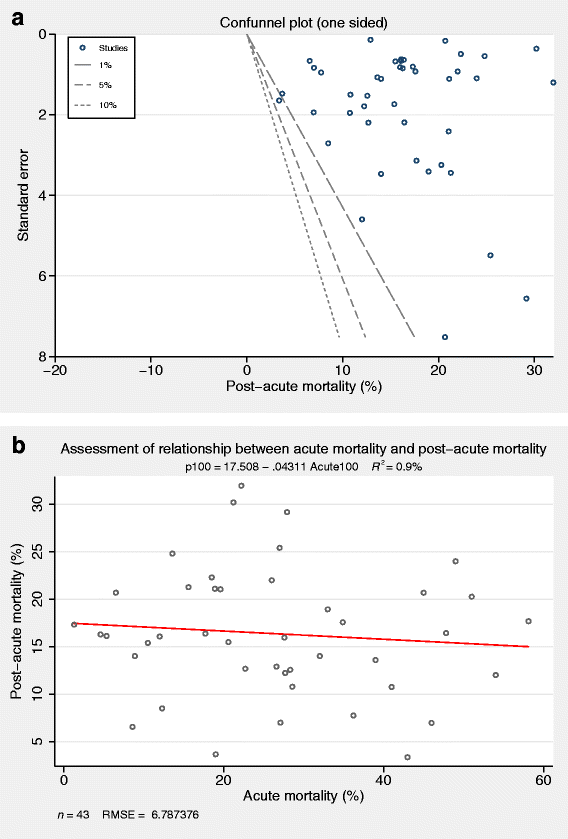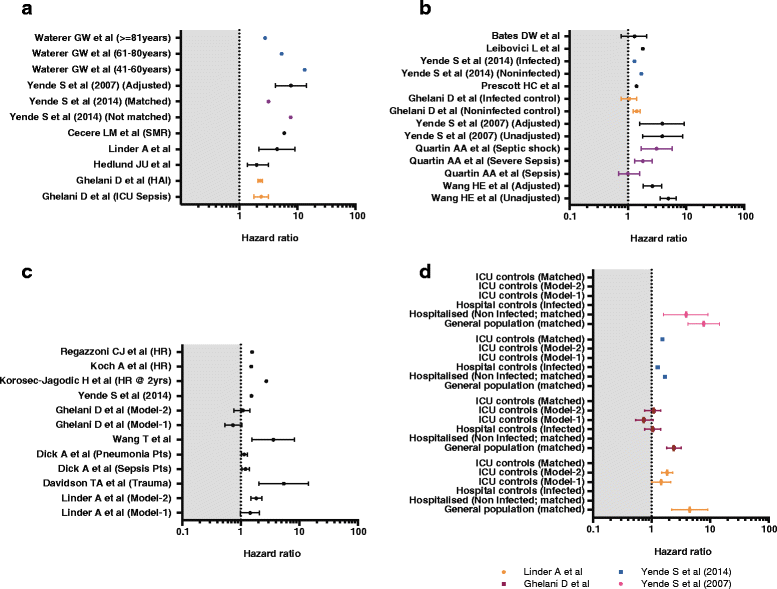Evidence for a causal link between sepsis and long-term mortality: a systematic review of epidemiologic studies
- PMID: 27075205
- PMCID: PMC4831092
- DOI: 10.1186/s13054-016-1276-7
Evidence for a causal link between sepsis and long-term mortality: a systematic review of epidemiologic studies
Abstract
Background: In addition to acute hospital mortality, sepsis is associated with higher risk of death following hospital discharge. We assessed the strength of epidemiological evidence supporting a causal link between sepsis and mortality after hospital discharge by systematically evaluating the available literature for strength of association, bias, and techniques to address confounding.
Methods: We searched Medline and Embase using the following 'mp' terms, MESH headings and combinations thereof - sepsis, septic shock, septicemia, outcome. Studies published since 1992 where one-year post-acute mortality in adult survivors of acute sepsis could be calculated were included. Two authors independently selected studies and extracted data using predefined criteria and data extraction forms to assess risk of bias, confounding, and causality. The difference in proportion between cumulative one-year mortality and acute mortality was defined as post-acute mortality. Meta-analysis was done by sepsis definition categories with post-acute mortality as the primary outcome.
Results: The literature search identified 11,156 records, of which 59 studies met our inclusion criteria and 43 studies reported post-acute mortality. In patients who survived an index sepsis admission, the post-acute mortality was 16.1% (95% CI 14.1, 18.1%) with significant heterogeneity (p < 0.001), on random effects meta-analysis. In studies reporting non-sepsis control arm comparisons, sepsis was not consistently associated with a higher hazard ratio for post-acute mortality. The additional hazard associated with sepsis was greatest when compared to the general population. Older age, male sex, and presence of comorbidities were commonly reported independent predictors of post-acute mortality in sepsis survivors, challenging the causality relationship. Sensitivity analyses for post-acute mortality were consistent with primary analysis.
Conclusions: Epidemiologic criteria for a causal relationship between sepsis and post-acute mortality were not consistently observed. Additional epidemiologic studies with recent patient level data that address the pre-illness trajectory, confounding, and varying control groups are needed to estimate sepsis-attributable additional risk and modifiable risk factors to design interventional trials.
Keywords: Bias; Causality; Confounding factors (epidemiology); Mortality; Sepsis.
Figures





Similar articles
-
Interventions for promoting habitual exercise in people living with and beyond cancer.Cochrane Database Syst Rev. 2018 Sep 19;9(9):CD010192. doi: 10.1002/14651858.CD010192.pub3. Cochrane Database Syst Rev. 2018. PMID: 30229557 Free PMC article.
-
Self-management interventions for people with chronic obstructive pulmonary disease.Cochrane Database Syst Rev. 2022 Jan 10;1(1):CD002990. doi: 10.1002/14651858.CD002990.pub4. Cochrane Database Syst Rev. 2022. PMID: 35001366 Free PMC article.
-
Drugs for preventing postoperative nausea and vomiting in adults after general anaesthesia: a network meta-analysis.Cochrane Database Syst Rev. 2020 Oct 19;10(10):CD012859. doi: 10.1002/14651858.CD012859.pub2. Cochrane Database Syst Rev. 2020. PMID: 33075160 Free PMC article.
-
Systemic pharmacological treatments for chronic plaque psoriasis: a network meta-analysis.Cochrane Database Syst Rev. 2021 Apr 19;4(4):CD011535. doi: 10.1002/14651858.CD011535.pub4. Cochrane Database Syst Rev. 2021. Update in: Cochrane Database Syst Rev. 2022 May 23;5:CD011535. doi: 10.1002/14651858.CD011535.pub5. PMID: 33871055 Free PMC article. Updated.
-
Systemic pharmacological treatments for chronic plaque psoriasis: a network meta-analysis.Cochrane Database Syst Rev. 2017 Dec 22;12(12):CD011535. doi: 10.1002/14651858.CD011535.pub2. Cochrane Database Syst Rev. 2017. Update in: Cochrane Database Syst Rev. 2020 Jan 9;1:CD011535. doi: 10.1002/14651858.CD011535.pub3. PMID: 29271481 Free PMC article. Updated.
Cited by
-
Dysregulated Immunity and Immunotherapy after Sepsis.J Clin Med. 2021 Apr 17;10(8):1742. doi: 10.3390/jcm10081742. J Clin Med. 2021. PMID: 33920518 Free PMC article. Review.
-
Single-cell deconstruction of post-sepsis skeletal muscle and adipose tissue microenvironments.J Cachexia Sarcopenia Muscle. 2020 Oct;11(5):1351-1363. doi: 10.1002/jcsm.12596. Epub 2020 Jul 8. J Cachexia Sarcopenia Muscle. 2020. PMID: 32643301 Free PMC article.
-
Impact of Baseline Characteristics on Future Episodes of Bloodstream Infections: Multistate Model in Septic Patients With Bloodstream Infections.Clin Infect Dis. 2020 Dec 15;71(12):3103-3109. doi: 10.1093/cid/ciz1206. Clin Infect Dis. 2020. PMID: 31858141 Free PMC article.
-
Influence of Sepsis on the Middle-Term Outcomes for Urinary Tract Infections in Elderly People.Microorganisms. 2023 Jul 31;11(8):1959. doi: 10.3390/microorganisms11081959. Microorganisms. 2023. PMID: 37630518 Free PMC article.
-
External validity of Adult Sepsis Event's simplified eSOFA criteria: a retrospective analysis of patients with confirmed infection in China.Ann Intensive Care. 2020 Feb 4;10(1):14. doi: 10.1186/s13613-020-0629-1. Ann Intensive Care. 2020. PMID: 32020406 Free PMC article.
References
-
- Fleischmann C, Scherag A, Adhikari NK, Hartog CS, Tsaganos T, Schlattmann P, Angus DC, Reinhart K, International Forum of Acute Care Trialists. Assessment of global incidence and mortality of hospital-treated sepsis - current estimates and limitations. Am J Respir Crit Care Med;193(3):259–72. - PubMed
Publication types
MeSH terms
LinkOut - more resources
Full Text Sources
Other Literature Sources
Medical
Miscellaneous

